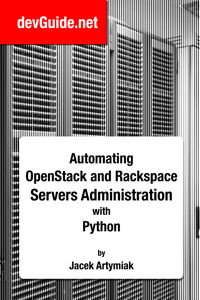Automating OpenStack and Rackspace Servers Administration with Python, 1st ed. [Kindle Edition]

Have you been hurt by the recent Amazon AWS outage? Would you like to see what else is out there and how you can use it? Try Rackspace and OpenStack. This book teaches you how to do it.
The use of cloud servers has become a common solution to many problems faced by the organizations whose needs for computing power and storage capacity change daily, often hourly. To make full use of the power of the virtual server farms that can grow or contract as needed, administrators need to configure the servers they are managing in a way that makes the machines more autonomous and resistant to failure.
Fortunately, those problems can be solved with mature Open Source and commercial products, because the designs for redundancy, backup, and failover of virtual servers are not much different than the designs used for real servers. The major difference is the speed of deployment and decommission.
What still needs to be tackled are the cloud server management issues and those still need to be automated with custom, in-house solutions. It would help to have one API (Application Programming Interface) to control servers running on different cloud platforms, but such thing does not currently exist and it won’t come soon for some time, if ever, because the major players in the cloud computing and the cloud storage space are not likely to unify their APIs for both practical and strategic reasons. While there is a lowest common denominator Python module called libcloud, it can only provide access to the very basic services offered by different cloud vendors.
Out of many players in the cloud server and the cloud storage area, Amazon and Rackspace are probably the ones that come to mind when we think of cloud computing.
While Amazon with their AWS (Amazon Web Services) is probably the most known cloud vendor that offers an API for cloud server and storage management, administrators who are considering building their server farms on a cloud platform ought to take a good look at the Rackspace Cloud Servers and Cloud Files services, both with a management API. To cite just one difference, Rackspace Servers offer persistency by default, which is something that Amazon AWS users have to take care of themselves using the building blocks provided by Amazon.
Technical details aside, the Rackspace cloud APIs are the ones to watch because of their decision to Open Source their Cloud Computing Software under the umbrella of the OpenStack project, which enables anyone to build a clone of the Rackspace Cloud as long as they have the required resources, of course. If that initiative takes off, Rackspace aka. OpenStack services and APIs may become more popular than their AWS equivalents.
Sample Chapters
Sign up for our free newsletter to be notified when our book ships!
Stay in touch with us via Facebook, Twitter, or our mailing list.
Copyright © 2011 devGuide.net ltd